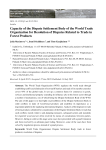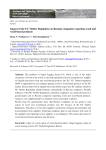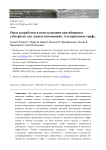Ресурсы. Рубрика в журнале - Resources and Technology

Статья научная
The World Trade Organization (WTO) regulates the world trade through establishing tariffs and elimination of non-tariff barriers and trade of its member countries covers 95% of the global trade. It sets up a common frame for commerce in goods, services and intellectual property extending its influence also to the forest sector through a number of mechanisms, one of which being the Dispute Settlement Body of the WTO. The aim of this paper is to shed light on possibilities of the Dispute Settlement Body to settle conflicts in trade of wood-based products and underline its importance as a negotiation platform for regulating international disputes. Analysis of the disputes in trade of forest products submitted for consideration of the Dispute Settlement Body reveals that such conflicts mostly relate to anti-dumping measures, safeguard actions and standards for exported wood and are often resolved by means of consultations between parties. However, failing to settle at this stage some cases have proceeded with a panel formation and been resolved by an ultimate panel ruling. Moreover, some of the cases have been solved by negotiation process instead of a panel process.
Бесплатно

Impact of the EU timber regulation on Russian companies exporting wood and wood-based products
Статья научная
The problem of illegal logging forced EU, which is one of the major consumers of wood in the world, to develop legislation aimed at termination of supplies of illegally harvested wood and wood-based products into EU. EU Timber Regulation №995 is applicable for any company placing wood or wood-based products on the EU market. Russia ranks first in illegally harvested timber export into EU markets, therefore EU Timber Regulation should influence substantially on Russian companies. Possible influence of the EU Timber Regulation on Russian companies was analyzed based on a questionnaire sent to Russian companies exporting wood and wood-based products. Analyses were supplemented by a literature review and expert’s opinion. Results from the questionnaire show that Russian companies are not going to stop export of wood and wood-based products into EU because of the EU Timber Regulation. They plan to revise their suppliers and internal company documentation and documentation from suppliers. Exporting companies plan to stop business with some of the suppliers and replacing by new suppliers is not obligatory. This means that export of wood and wood-based products may decrease.
Бесплатно

Опыт разработки и использования контейнерных субстратов для лесных питомников. Альтернативы торфу
Статья научная
Для широкого внедрения технологии выращивания посадочного материала хвойных пород с закрытой корневой системой, обеспечивающей процесс создания лесных культур качественным посадочным материалом, необходимо производство контейнерного субстрата с оптимизированными физико-химическими характеристиками, гарантирующими нормальное развитие корневой системы и полноценное питание растений. Рассмотрены критерии оценки качества контейнерных субстратов, некоторые области их использования, этапы их разработки в историческом аспекте. Лучшим для выращивания сеянцев в лесопитомниках традиционно считался субстрат из верхового сфагнового торфа, однако в течение последних лет было вложено много средств и усилий в разработку и испытание альтернативных торфу вариантов компонентов субстратов в связи с экологическими проблемами, возникающими в результате торфодобычи. Любой потенциальный заменитель торфа должен иметь подходящие характеристики, быть доступным в значительных количествах, унифицированным и экономически совместимым с потенциальным рынком. Из множества альтернатив торфу в качестве компонентов субстратов наиболее прочно утвердились некоторые компостированные биоотходы, кора и компост из коры, древесно-волокнистые материалы и кокосовые отходы. Показана пригодность древесных субстратов в качестве альтернативы торфу, но дополнительное внесение удобрений требуется, если торф не включен, по крайней мере, в количестве 40 процентов. Существующее на ЦБК оборудование позволяет перерабатывать круглые лесоматериалы, тонкомерную древесину, а также порубочные остатки с получением в качестве конечного продукта щепы различного назначения. Испытано доизмельчение щепы в компонент субстрата с использованием мельницы дискового типа.
Бесплатно

